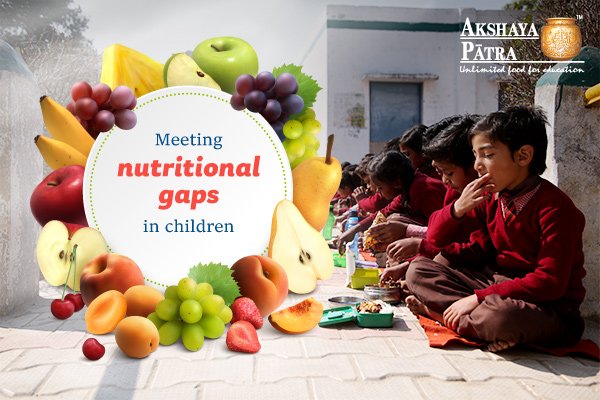
Praveen Kumar is a mid-day meal beneficiary who studies in 6th grade of GHPS, Siddeshwaranagar, Dharwad, Karnataka. During the lockdown period, he missed his school, teachers, friends and having mid-day meals (MDM). To support the health, immunity, hygiene and education of such children, The Akshaya Patra Foundation initiated The Happiness Kit Programme when the midday meal scheme was paused. Children like Praveen received food essentials from this NGO in India that would help them gain the required nutrition when schools were closed.
Praveen is happy to be back to school and meet his friends and teachers. He is particularly excited about enjoying the midday meals served in school.
Akshaya Patra focuses on food consumption by beneficiary school children and ensures the midday meal nutrition requirements by providing adequate amounts of nutrients like protein and energy as per the given MDM guidelines.
A cooked mid-day meal provides:
Components Primary Upper Primary
Calories 450 Cal 700 Cal
Protein 12 gm 20 gm
Micro-nutrients Adequate quantities of micro-nutrients like Iron, Folic Acid, Vitamin-A, etc.
The recipes used by Akshaya Patra contain different food groups (Cereals, pulse, vegetables, spices, sugars and jaggery, oils, etc.) to ensure that the nutrients are received by the beneficiary group.
The recipes are standardized by calculating nutritive values by referring to the book - Nutritive value of Indian foods by C Gopalan, BV Rama Sastri and SC Balasubramanian-National institute of Nutrition ICMR Hyderabad) and recipes are analysed in external NABL-accredited labs.
INNOVATIVE MENU DESIGNED AS PER THE MIDDAY MEAL SCHEME
Akshaya Patra has adopted innovative approaches to enhance the nutrient content of the MDM menu and increase its consumption. One such approach is to add a third item and introduce sweets and pickles in various locations. Another approach is to make the existing items more palatable and interesting. These elements enhance the taste and offset the menu fatigue that might set in children. The menu has a variety of flavours, such as sweet, spicy, etc.
New Product Development Centres (NPDC) have also been set up to make mid-day meals more nutritious and interesting by developing new recipes and opting for in-recipe modifications.
AKSHAYA PATRA SERVES HEALTHY SNACKS
State Name of Snack/ Fruit item served
Andhra Pradesh Groundnut chikki, Banana etc.
Telangana Boiled chana, Boiled Lobia, Groundnut chikki etc.
Gujarat Roasted Split Masala Sing, Sweet Churma, Fortified Biscuits,
Roasted Desi Chana Chat, Ground Nut fry, Moong dal fry, chana dal fry, etc.
Karnataka Fruit ( Banana), Avalakki fry, Moong dhal fry,
Usli (Green gram/ Bengal gram),
Rajasthan Fruits (Banana/Orange) etc.
Uttar Pradesh Seasonal Fruits (Banana/Orange) etc.
These snacks are a hit among children who receive locally palatable meals. They enjoy these seasonal fruits that they can snack upon in the evening while they go back home. Every meal is prepared in a hygienic manner with great caution.
The Foundation has centralised and decentralised kitchens in 58 locations spread across 13 states & 1 union territory of India. The kitchens are known for their efficiency and efficacy. Every centralised kitchen is automated and can cook close to 6,000 kg of rice, 4.5-5 tonnes of vegetables and 6,000 litres of sambar in only 4 hours. To ensure that the waste generated in the kitchens are discarded in a safe manner, the NGO in India has set up anaerobic digestion plants to produce biogas. This biogas is then used as cooking fuel for seasoning, etc.
AKSHAYA PATRA’S COOKING PROCESS
After meeting the FQMS process that includes Supplier Selection, Supplier Qualification, Supplier Rating, etc., a set quantity of raw materials are procured. The Quality Control process ensures that all the raw materials are accepted only after a thorough Quality Inspection. The raw materials are procured only if they meet all the Raw Material Specifications that are adapted from Food Safety Standards Act 2006 (FSSA). To ensure that all the raw materials are fresh, the kitchens follow the FIFO (First In First Out) and FEFO (First Expiry First Out) methods. With this method, it can properly identify, store and aptly retrieve the raw materials.
• The operations of the kitchens start early in the morning around 4-5 am.
• The kitchen employees begin cleaning all the pulses, rice and vegetables with water.
• All the helpers begin cutting vegetables and preparing for the meals. The vegetable cutting machines finely chop other vegetables like potato and onion, while the vegetable peelers skin out vegetables like potato, radish, carrots, etc.
• Recipes are standardised across the kitchens so that safety, hygiene and taste are not compromised.
The vessels used in the cooking process are made of stainless steel of 304 food grade. All the equipment used in the kitchen, including cauldrons, trolleys, rice chutes, sambar and dal tanks, knives, etc. are made of SS-304 grade. This ensures that no hazardous material or toxins enter the food that is cooked for the nourishment of children.
• Once the food is prepared, they are loaded onto insulated vessels that are waiting to be filled in the conveyor belt.
• A quality check, temperature check is carried out at regular intervals
• These vessels are then packed, sealed and loaded onto the delivery vans.
Delivery vans are designed in a manner that retains heat, avoids spillage and has more capacity to deliver to many schools. The specially built delivery vehicles are insulated to preserve the ideal temperature, are dust-free, and aid in the preservation of the meals' freshness. Akshaya Patra customises its delivery vehicles with insulated bodies and honeycomb constructed racks to carry large containers.
When these delivery vans reach Government and Government-aided schools well before the lunch break, the food remains hot. This means that children can enjoy locally palatable meals that are fresh, nutritious and hot on their plate. Support the feeding of school children coming from challenging backgrounds with your online donations.
Write to us if you want to know about which food item is served in which state.
Refer to the following links for more information:
https://www.akshayapatra.org/tax-exemption-donation-faqs
https://blog.akshayapatra.org/5-sustainable-development-goals/